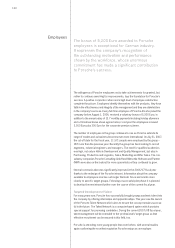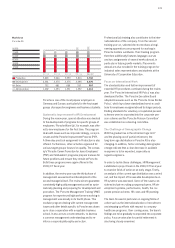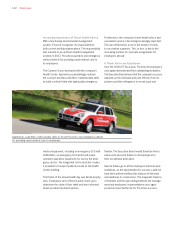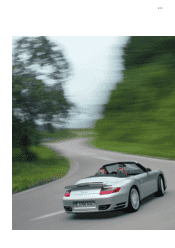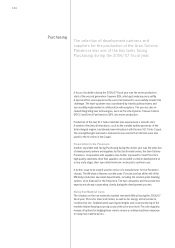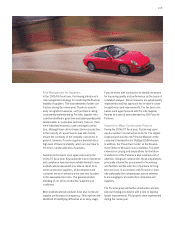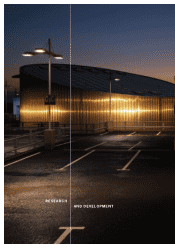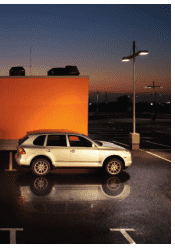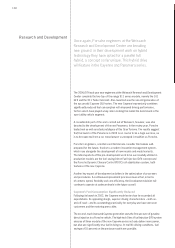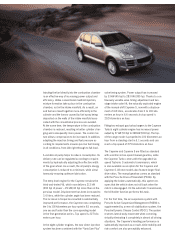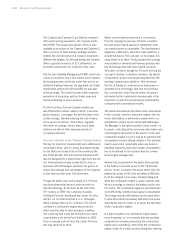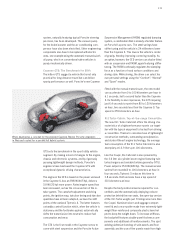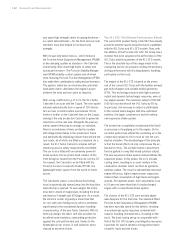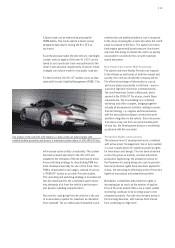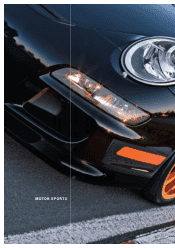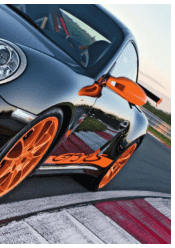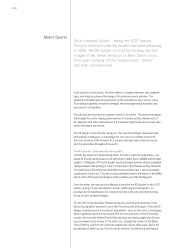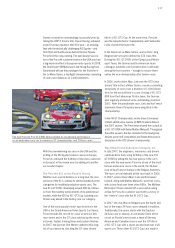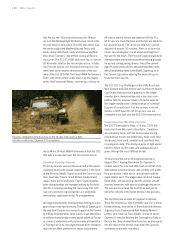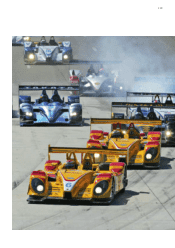Porsche 2006 Annual Report Download - page 112
Download and view the complete annual report
Please find page 112 of the 2006 Porsche annual report below. You can navigate through the pages in the report by either clicking on the pages listed below, or by using the keyword search tool below to find specific information within the annual report.
110
The Cayenne and Cayenne S are fitted as standard
with a steel spring suspension, the Cayenne Turbo
with PASM. This suspension variant, which is also
available as an option for the Cayenne and Cayenne S,
offers a choice of three damper settings and also
enables the vehicle body to be raised or lowered to
different ride heights. For off-road driving, the Cayenne
offers a ground clearance of 271 millimeters, an
excellent achievement for a vehicle in this class.
The Porsche Stability Management (PSM), which also
comes as standard, has a new feature which readies
the braking system and brake assist function for an
imminent braking maneuver. An upgraded car/trailer
stabilization system and offroad ABS are also part
of the package. The result is faster brake response,
prevention of hazardous vehicle/trailer sway and
improved braking on loose surfaces.
For the first time, the new Cayenne models are
also fitted with a rollover sensor, which, in an emer-
gency situation, can trigger the belt tensioners and
curtain airbags, thereby reducing the risk of injury
in the event of a rollover. This feature, together
with other six airbags, means these sport utility
vehicles are able to offer exemplary levels of
occupant protection.
Porsche’s Answer to the Climate Change Debate
The key focal point of development work at Weissach
is the hybrid drive, which is being developed initially
for the SUVs and is due to be on the market by the
end of this decade. The Gran Turismo Panamera will
also be designed for a hybrid drive right from the out-
set. Development is being conducted in close co-
operation with Volkswagen and Audi. The goal is to
reduce the average fuel consumption of the Cayenne
to less than nine liters per 100 kilometers.
Though the public may not be aware of it, Porsche
has done pioneering research and test work on
hybrid technology. As far back as the end of the
19th century, in 1899, the company’s founder,
Ferdinand Porsche, developed the Lohner Porsche
electric car for what was then k. u. k. Hofwagen-
fabrik Ludwig Lohner & Co. in Vienna. The vehicle
combined a combustion engine and an electric
motor and was able to store energy in a battery.
One could say that it was the first hybrid car and it
caused quite a stir at the Paris Exhibition in 1900.
From a concept point of view, the Lohner Porsche
was way ahead of its time.
Where current development work is concerned,
Porsche is going its own way. Porsche considers
the split-power hybrid approach adopted by most
car manufacturers as unsuitable. The development
engineers in Weissach, therefore, have opted for a
parallel full hybrid. This concept, so far unique, has
many things in its favor. Firstly, greater fuel savings
are possible on overland and freeway journeys with
this technology than with other hybrid concepts.
This alone is reason enough for Porsche to bring the
concept to fruition. In addition, however, the hybrid
components can be more easily integrated into the
existing Cayenne basic platform. This minimized
the risk of having to compromise on load space or
all-wheel drive technology. And, last but not least,
this concept also suits Porsche better, because it
will enable further substantial improvements in the
Cayenne’s acceleration performance and flexibility
compared with conventional models.
The interaction between the three main components
in this concept, namely combustion engine, electric
motor and battery, is extremely complex and is co-
ordinated by what is known as the Hybrid Manager.
The Manager is the hybrid system’s nerve center, so
to speak, collecting all the necessary information and
controlling the interaction of the electric motor and
combustion engine in such a way as to optimize fuel
consumption in every driving situation. This achieve-
ment is even more remarkable when one bears in
mind that around four times the number of parameters
has to be defined for this system than for conven-
tional engine management.
Another key component of the hybrid drive system
is the battery to provide power to the 38 kilowatt
electric motor. Located in the spare wheel well, the
battery has a total of 240 cells and delivers 288 volts.
It can be charged in two ways: during braking and
when the combustion engine is under a lesser load,
electrical energy is stored in the battery by the elec-
tric motor. The combustion engine is operated even
more efficiently, thereby reducing fuel consumption.
The energy stored in the battery can be used either
to drive the vehicle exclusively with electrical power
aided by the electric motor, or to assist the operation
of the combustion engine.
In a hybrid system, the combustion engine stops
more frequently, so it is essential that any ancillary
components normally powered by the combustion
engine work seamlessly, even when the combustion
engine is idle. As a result, an electrohydraulic steering
Research and Development


